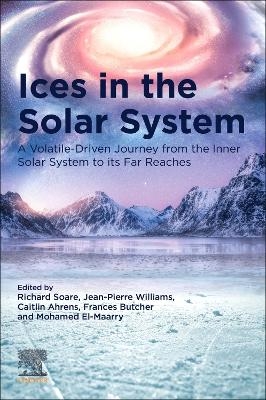
Ices in the Solar-System
Elsevier - Health Sciences Division (Verlag)
978-0-323-99324-1 (ISBN)
Richard Soare is a physical geographer specializing in periglacial (cold-climate, non-glacial landscapes). Through the last twenty years he has spent considerable time in the Canadian arctic (physically) and off-planet (intellectually), attempting to identify landscapes on Mars present or past possibly molded by the freeze-thaw cycling of water. His work spans the red planet geographically, ranging from the plains of Utopia Planitia in the northern hemisphere and the Moreux impact-crater at the Mars dichotomy through to the Argyre impact-crater in the southern hemisphere. Recently, he lead-edited “Mars Geological Enigmas: from the late Noachian Epoch to the present day and a special issue of Icarus: “Current and Recent Landscape Evolution on Mars. Jean-Pierre Williams is a planetary scientist at the University of California in Los Angeles (UCLA). He received his PhD in Geophysics and Space Physics from UCLA and was a research scientist at the California Institute of Technology (Caltech) for five years before accepting a position at UCLA. His work focuses on the geology and physics of the inner planets, and he has authored and co-authored over sixty peer-reviewed publications on Mars, Mercury, and the Earth’s Moon. He is currently the Deputy Principal Investigator of the Diviner Lunar Radiometer Experiment on the Lunar Reconnaissance Orbiter, a member of the ShadowCam instrument team on the Korean Pathfinder Lunar Orbiter (Danuri) mission, which will image the permanently shadowed regions near the poles of the Moon, and a Co-Investigator of the Lunar Vulkan Imaging and Spectroscopy Explorer (Lunar-VISE), a lander and rover that will explore the summit of a volcanic dome on the Moon. Caitlin Ahrens is a postdoctoral research scientist at NASA Goddard Space Flight Center, Greenbelt, Maryland. Dr. Ahrens received her B.S. in Physics/Astrophysics and Geology from West Virginia University in 2015, and a Ph.D. in Space and Planetary Science at the University of Arkansas in 2020. She has an outstanding record in public engagement and science communication, through lectures, local radio, and international collaborations. Her main area of research involves remote sensing of icy surfaces and volatile interactions, from the Moon to the outer Solar System at Pluto. Frances Butcher is a Leverhulme Trust Early Career Fellow at the University of Sheffield in the UK. She completed her PhD, entitled ‘Wet-Based Glaciation on Mars’, at the Open University in 2019. She is a geomorphologist whose research focuses on glaciation and other ice-related processes on Mars and Earth. Her particular interest is in the landforms left behind by glaciers and ice sheets, and their implications for past environmental change on both planets. Her research involves the use of remote sensing data for mapping and quantitative 3D terrain analyses, as well as interplanetary comparisons. These techniques inform empirical and numerical modelling reconstructions of glacial processes and past environmental change. To date, she has authored/co-authored 17 peer-reviewed publications. She is currently the chair of the International Association of Geomorphologists Planetary Geomorphology Working Group. Mohamed Ramy El-Maarry is currently the director of the Space and Planetary Science Center and an associate professor of planetary sciences at Khalifa University in Abu Dhabi, the United Arab Emirates. He has been involved with numerous space missions in the past 15 years for both ESA and NASA, including ESA’s Rosetta mission to comet 67P/Churyumov-Gerasimenko, and ESA’s ExoMars Trace Gas Orbiter mission, in addition to being on the science teams for numerous other active and future missions including the HiRISE camera on board NASA’s Mars Reconnaissance Orbiter, ESA’s Comet Interceptor mission, and the UAE’s upcoming Emirates Lunar Mission. His research covers planetary surfaces with a focus on geomorphology and associated physical processes. In addition to his research activities, he has participated in numerous reviewing and expert NASA and ESA evaluation panels.
Introduction Prologue I: The Solar System’s ices and their origin Prologue II: The Ice Frontier for Science in the Upcoming Decades: A strategy for Solar System Exploration? 1: Cold-trapped ices at the poles of Mercury and the Moon 2: Glacial and periglacial processes on Earth 3: Mars, glacial (early) 4: Glacial deposits, remnants and landscapes on Amazonian Mars: Using setting, structure, and stratigraphy to understand ice evolution and climate history 5: Evidence, arguments and cold-climate geomorphology that favour periglacial cycling at the Martian mid-latitudes in the Late Amazonian Epoch 6: Ice exploration on Mars: whereto and when? 7: Ceres - Remnants of an ancient ocean world 8: Small icy bodies in the inner solar system 9: Icy ocean worlds in the Jupiter system 10: Titan, Enceladus and other icy moons of Saturn 11: Cryogeology of KBO Pluto and the icy satellites of Uranus and Neptune
| Erscheinungsdatum | 03.11.2023 |
|---|---|
| Verlagsort | Philadelphia |
| Sprache | englisch |
| Maße | 152 x 229 mm |
| Gewicht | 450 g |
| Themenwelt | Naturwissenschaften ► Physik / Astronomie ► Astronomie / Astrophysik |
| ISBN-10 | 0-323-99324-9 / 0323993249 |
| ISBN-13 | 978-0-323-99324-1 / 9780323993241 |
| Zustand | Neuware |
| Haben Sie eine Frage zum Produkt? |
aus dem Bereich


